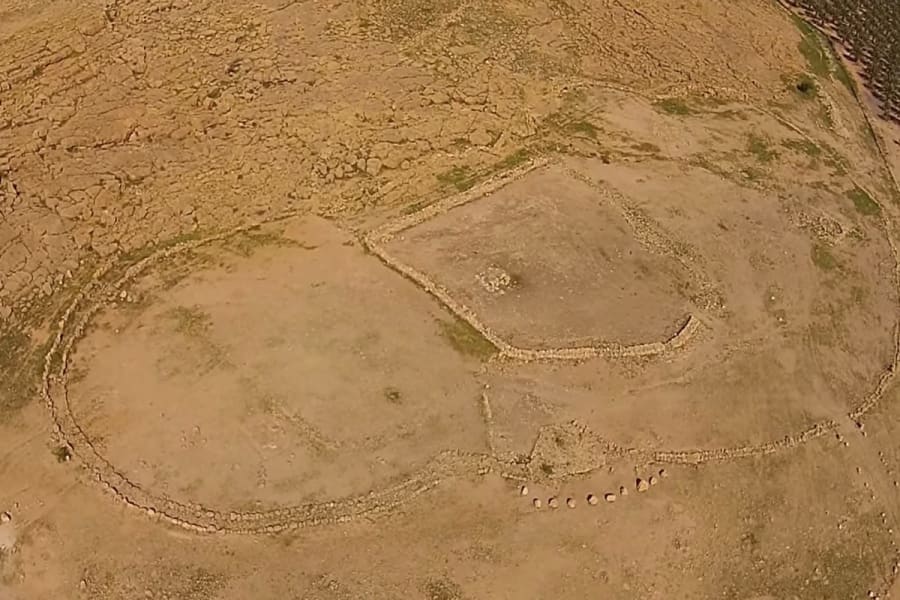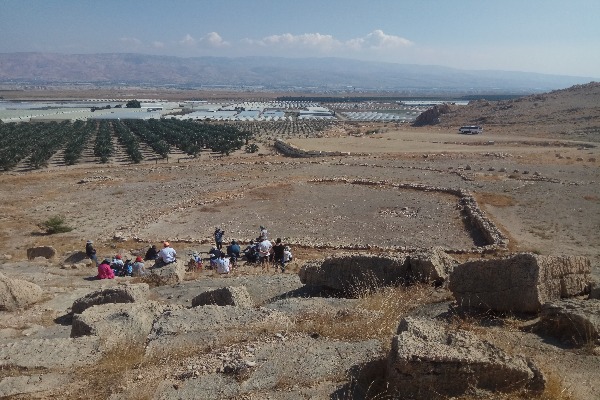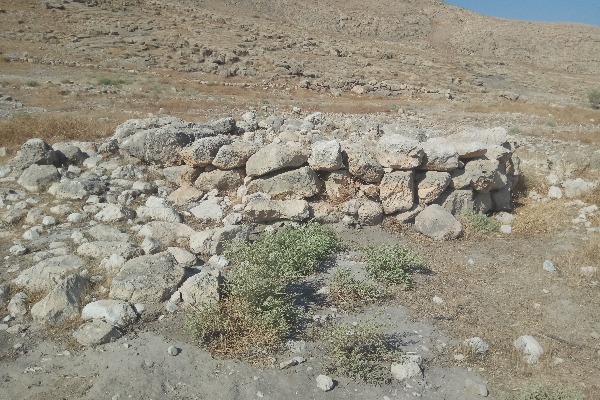Discover the enigmatic and unusually-shaped site of one of the biblical Gilgals in the Jordan Valley
The “Gilgals” were focal points for the tribes of Israel

The archaeological landscape of ancient biblical Israel is adorned with enigmatic sites.
The Bible refers to multiple sites as Gilgal, consistently depicted as significant gathering places for the Israelites. The most famous of these is mentioned in Joshua 4:19.
Another Gilgal, the Argaman Foot site, also called “Gilgal Argaman,” situated near the modern Moshav Argaman in the Samaria-Jordan Valley area, emerges as a particularly intriguing puzzle, inviting speculation and inquiry into its origins and significance.
Spanning a vast expanse of 14 dunams (3.45 acres, or 0.014 square kilometers), this meticulously crafted and foot-shaped complex has captivated the imagination of scholars and enthusiasts alike, offering a tantalizing glimpse into ancient Israel's religious and social practices.
The site is quite unknown to many. Israeli tourists will typically visit some other iconic biblical sites, such as Caesarea-Maritima, Masada, the Old City of Jerusalem, Nazareth, and others. However, the Gilgal site is already well known by many archaeologists, Christian scholars, pastors, Jewish Rabbis and scholars. On occasion, Evangelical Christian tour groups will also spend extra time visiting this site, which deserves more attention from Bible history seekers.
At the forefront of exploration and interpretation at the Gilgal site is Dror Ben-Yosef, whose meticulous excavations between 2003 and 2008 have unearthed a wealth of insights into the Gilgal Argaman. The site's distinctive foot-shaped stone wall enclosure, coupled with its array of accompanying features, including a round altar made of unchiseled stones and square enclosures, suggests a deliberate effort to convey a profound message connected to the ancient Israelites.
The presence of a procession path winding through the site further underscores its ceremonial significance, hinting at rituals and Israelite religious practices that most probably took place within its confines.

Today, most scholars agree on dating the site to the period of the Judges and to the Kingdoms of Judah and Israel, the early and mid-Iron Age in the Levant, either from 1400 B.C. (depending on interpretation) or 1200 B.C., until the 8th century B.C. The date is generally based on the context, the finds (pottery typology) and the biblical sources.
Central to the interpretation of the Gilgal Argaman site is the groundbreaking work of Adam Zertal, whose pioneering studies have reshaped our understanding of ancient Israelite culture.
Despite sustaining a severe injury during his military service, Zertal later became an exceptional archaeologist, uncovering significant sites and insights into the study of ancient Israel.
His most notable achievements are:
1. The 1978 Manasseh Hill Country Survey: A comprehensive survey of approximately 3,000 square kilometers in the northern and central Samaria and the Jordan Valley.
2. Identification of six cultic sites of Gilgalim – foot-shaped sites in the Jordan Valley.
3. The discovery and excavation of the Altar on Mount Ebal, interpreted as Joshua's Altar.
4. The "El-Ahwat" archaeological site – known as the "Harosheth of the Gentiles."
Zertal asserted that the foot-shaped “gilgal sites” (plural “gilgalim” in Hebrew) symbolize themes of ancient Hebrew land ownership, national identity and spiritual authority. These challenge conventional interpretations of biblical texts and the usual, secular academic archaeological interpretation.
By linking the "foot" motif to the ancient Hebrews, who adopted it from Egyptian traditions of subjugation and control, Zertal offers a compelling interpretation of the symbolic importance of these enigmatic archaeological sites.
Zertal wrote a trilogy of related biblically-themed books, with one of them directly connected to the Gilgals: “The Footsteps of God: The Discovery of Israelite Gilgal Sites Dating to the Iron Age.”
While Zertal mentions the “gilgal” in plural (“gilgalim”), could the “Gilgals” be several different places mentioned in the Bible?
Indeed, the Gilgal Argaman site is not an isolated phenomenon but part of a larger network of foot-shaped “gilgalim” scattered throughout the region of modern Israel. From Masua to Tirzah Valley, these sites share common features such as their distinctive layout and lower positioning relative to their surroundings.
The term "Gilgal" in biblical context refers to a category of sites rather than one specific location. These 39 Gilgals mentioned in the Bible were primarily situated in the Jordan Valley and the hill country. Functioning as focal points for the tribes of Israel, they served various purposes including gatherings, worship, legal proceedings, and military preparations (as mentioned in the Bible).
This activity spanned from the settlement and Judges era (12th-10th centuries B.C) through the monarchy period (9th-8th centuries B.C). Scriptural references to Gilgal are found in the books of Deuteronomy, Joshua, Judges, Samuel, and Kings, and later in the prophetic writings of Hosea, Amos, Micah, and Nehemiah.
The site of Gilgal Argaman and his footprint shape reminds us, of course, of the well-known Bible verse in Deuteronomy 11: 24: "Every place on which the sole of your foot treads shall be yours: from the wilderness and Lebanon, from the river, the River Euphrates, even to the Western Sea, shall be your territory."

The presence of round altars and square enclosures at the Gilgals, and specifically at the Gilgal Argaman site, suggests a complex interplay of religious tradition and ritual practices including sacrifices to the God of Israel as part of the Levites' and the priest's liturgy.
The presence of solely kosher animal bones found at the round altar inside the Gilgal Argaman site, coupled with the enclosure's footprint-like shape, strongly suggests this was a post-nomadic Hebrew worship site dating back to the period of the Judges and after.
The Gilgal Argaman site stands as a testament to the enduring allure of biblical archaeology, offering a window into the religious beliefs and social practices of ancient Israel.
Through meticulous excavation and interpretation, scholars continue to unravel the mysteries of this enigmatic site, shedding light on its significance in the broader context of Israelite history and culture.
As we delve deeper into the secrets of the Gilgal Argaman and its counterparts, we gain invaluable insights into the importance of archaeological inquiry in preserving and understanding the Bible’s history.

Aaron Goel-Angot is a Belgian-Israeli archaeologist with an expertise in antiquities identification. He is an enthusiastic numismatist and a licensed tour guide. He holds a BA degree in archaeology from the Institute of Archaeology at the Hebrew University of Jerusalem. He joined the ALL ISRAEL NEWS team as an Archaeology and Tourism correspondent. Aaron is married, father of three young children and lives in Jerusalem.
You might also like to read this:














